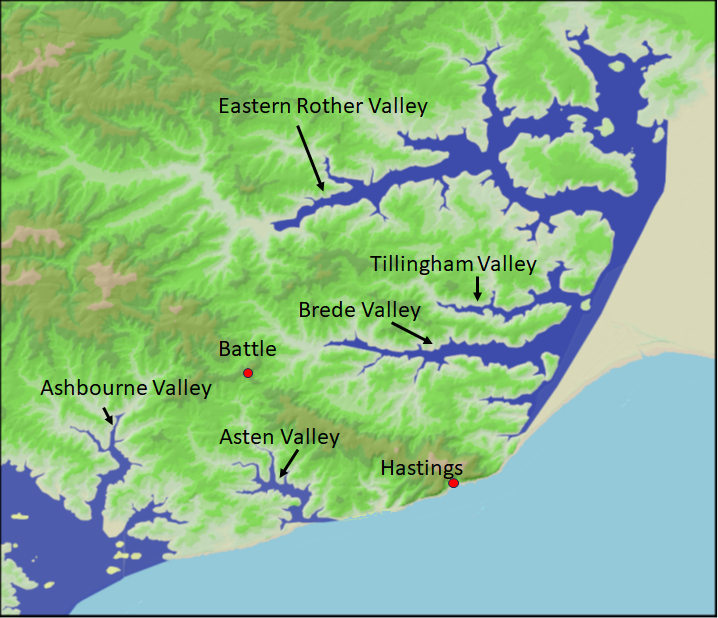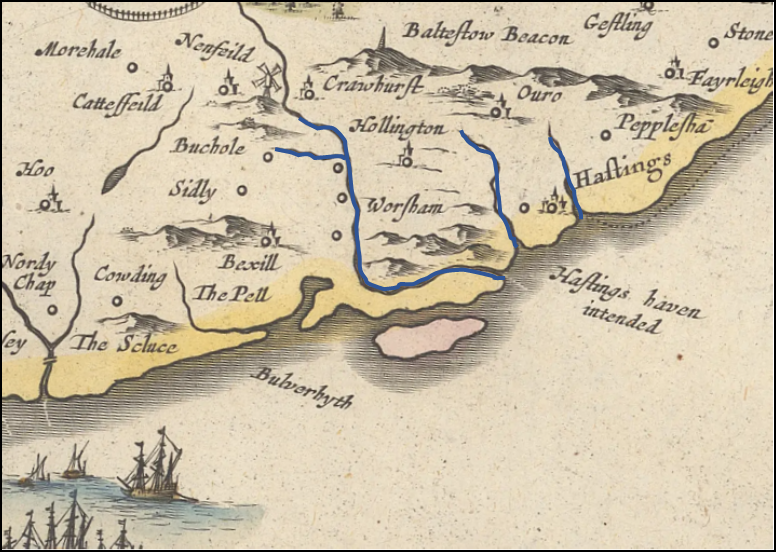|
 | Anglo Saxon History |  | |
| | Battle of Hastings 1066AD - Summary of the Battle of Hastings |
|---|
| |
|---|
| My current thoughts and summary of the events |
|---|
| | The Ship List of William ▲ |
|---|
The Ship list provides a starting point for the invasion as it provides a number of vessels probably leaving Dives.
If you are interested in the force size that this fleet could possibly carry then please click the next button where we
try to explain a possible scenario.
In summary, William the Conqueror's ship list reveals the intricate organization of a maritime power during the Middle
Ages and the critical role played by harbor-towns and their Lords in William’s preparations for the invasion of
England.
| | |
|---|
Ships - Drekka, Snekkja and Knarr ▲
|
|---|

Normandy was first raided by the Vikings in 790AD and then settled by Vikings in about 840AD, so the Normans would
use Viking technology for their ships.
Viking longships, also known as longboats, were versatile Scandinavian warships used for commerce, exploration, and
warfare during the Viking Age. While their primary purpose was not to transport horses, they could potentially carry a
limited number of them.
There were two types of ships, the first a warship called a Snekkja (meaning snake) with a larger variant called Drekka
(meaning dragon) which was usually a commanders vessel and had a dragon shaped prow.
The second was a transport ship called a Knarr (meaning merchant ship) which was wider and carried heavier loads and its
smaller relative the Karve (meaning a caraway).
| | Why land at Hastings ▲ |
|---|
So we have an area that is rich in iron ore and has been exploited from before Roman times to make nails and other iron
implements, and has a plentiful supply of oak trees to make ships (The Great Forest of Andredsweald - Anglo Saxon
Chronicles).
The early Britons were exporting iron to the continent, and this probably in turn attracted the Roman conquest to
exploit this for weapon manufacture. The Romans were here for about 350 years and built Pevensey and Portus
Lemanis(Stutfall) Castles to defend their iron exports and their shipbuilding. The iron production appeared to drop
significantly (see Wealden Iron Research Group) after Caurausius and Allectus were killed and the Roman Empire retook
Britannia, but the shipbuilding must have continued due to the proximity of the oak forest to the ocean.
The Saxons took over the area probably about 460AD between the landings of Henghest and Horsa and the South Saxons of
Aelle. This was probably to take over the old Roman shipbuilding areas in the Filsham and Ashbourne valleys.
The Vikings Great Army stayed at Appledore for some time in 893AD the most likely reason was to build more ships on the
Rother as there was nothing else for them in this area and it was away from the main ports at Hythe and Hastings.
The Vikings moved north and Alfred the Great built a Burh(fort) at Hastings most likely at Baldslow Down(Harrow Playing
Fields) due to the etymology and location.
The Normans then invaded the Hastings area and re-fortified the Burh and Pevensey Castle.
So this is now conjecture, but its recorded that the area was a major shipbuilding area from the
1200's to the 1500's, it would also seem likely that the area was a major shipbuilding area from Roman times as well.
If William invades and wants to get Harold's attention what better way than to take some of the major Saxon shipyards.
Williams troops contained many cavalry troop that were not really suitable for fighting in wooded areas. These cavalry
would have been better utilised in battles on the flat farmlands of Kent, so why else come to this area.
| | Dives sur Mer to St Valerie and a Storm ▲ |
|---|
If the Williams Ship List showing 777 ships and Master Wace's 694 ships leaving St Valerie are true
then the fleet would have lost 81 ships between Dives and St Valerie.
This would have been over 10% of the fleet, which would make the report from William of Poitiers of concealment of the
drowned fairly important, as there would have been a significant number possibly in the hundreds of troops, horses and a
great deal of supplies.
| | St Valerie to Pevensey ▲ |
|---|
The Carmen provides the only details of the journey
From the Carmen the only logical route is from St Valerie to the Colbart Ridge off the coast from New
Romney to anchor till dawn, then sail along the coast towards the west, this measures approximately 146km.
This also provides an explanation for the New Romney issue, as overloaded or sinking vessels would aim for the nearest
shore which would have been New Romney.
I now have a logical explanation for why some of the ships may have been overloaded, please see An analysis of Duke Williams forces for my thoughts on the
subject.
| | The Coastline and Landscape ▲ |
|---|
The Hastings area is very isolated, and would have only been accessible via ships along the coast or
via the old Roman Roads and Celtic Ridgeways through the Forest of Andredsweald.
It seems a strange place to invade with cavalry unless something else was important in the area, please click the
following link for my thoughts Battle of
Hastings 1066AD - C - Why Hastings?
| | New Romney Destroyed ▲ |
|---|
It seems unlikely they would have landed in Romney by error as 700 ships were sailing together, it is
much more likely that the vessels were taking on water and they needed to reach the nearest shore, and if the route went
from the Colbart Ridge to Pevensey, then Romney would have been the nearest shore line.
Please look at our 'An analysis of Duke Williams forces'
page for a possible explanation of why ships may have been overloaded.
| | Landscape of Haestingaport ▲ |
|---|
|
This is the final rendering of the map of Hastings in about 1066AD
|
 If you look at the Lidar map to the left you can see that the ridges
seem to run to the South East, and the majority of the small streams running off these go either north east or south
west. (clicking on the maps will show a larger map). If you look at the Lidar map to the left you can see that the ridges
seem to run to the South East, and the majority of the small streams running off these go either north east or south
west. (clicking on the maps will show a larger map).
This map also shows that Hastings was on a Peninsular, with the Rother to the east and the Ashbourne to the west
limiting travel. The narrowest point on the peninsular is near modern Netherfield.
 Also from the more detailed Lidar map it would seem likely that there
was a promontary into the sea near to modern Cooden (originally known as Cooling). To the east there is the area around
Bexhill near to Pelham park where the Pell stream reached the sea. Further east there was another promontory that
protruded from the Galley Hill area near to modern Bulverhythe and out into the Channel, which would most likely have
streams that reached the sea towards the north east or south west. Also from the more detailed Lidar map it would seem likely that there
was a promontary into the sea near to modern Cooden (originally known as Cooling). To the east there is the area around
Bexhill near to Pelham park where the Pell stream reached the sea. Further east there was another promontory that
protruded from the Galley Hill area near to modern Bulverhythe and out into the Channel, which would most likely have
streams that reached the sea towards the north east or south west.
 If John Speed's map of 1610AD was correct then there was an island off
Bulverhythe and St Leonards. This implies that the land was originally further out, and the island is also to the south
east of Galley hill which would be logical if there was a promontary there. This map also shows the Aspen river running
along the modern St Leonards sea front towards Hastings. If John Speed's map of 1610AD was correct then there was an island off
Bulverhythe and St Leonards. This implies that the land was originally further out, and the island is also to the south
east of Galley hill which would be logical if there was a promontary there. This map also shows the Aspen river running
along the modern St Leonards sea front towards Hastings.
This map also implies what may have happened in the 1287AD storm (see Landscape - The 1287AD Storm and its effect on the Kent
and Sussex Coast).
Here is the basis for the final map
If the land was originally a promontory, and there were streams running south west and north east, its
possible that the 1287AD storm broke through a weakened area behind the 1610AD island and deposited vast amounts of
shingle into the estuary of the Asten river blocking Combe Haven and across the Haestingaport harbour where the current
Shopping Centre at Priory Meadow was.
This would have forced the Town to relocate to the position of the Old Town of Hastings where the net shops and fishing
fleet currently are.
The 1610AD Island appears to have eroded away by the mid 1700's, so the promontory could have been even further out than
my map shows.
|
|
|
|
|
| |
|
|
Local Interest
Just click an image |
|
|
|
|
|
|
|
|
|
|
|
|
| |
|
|